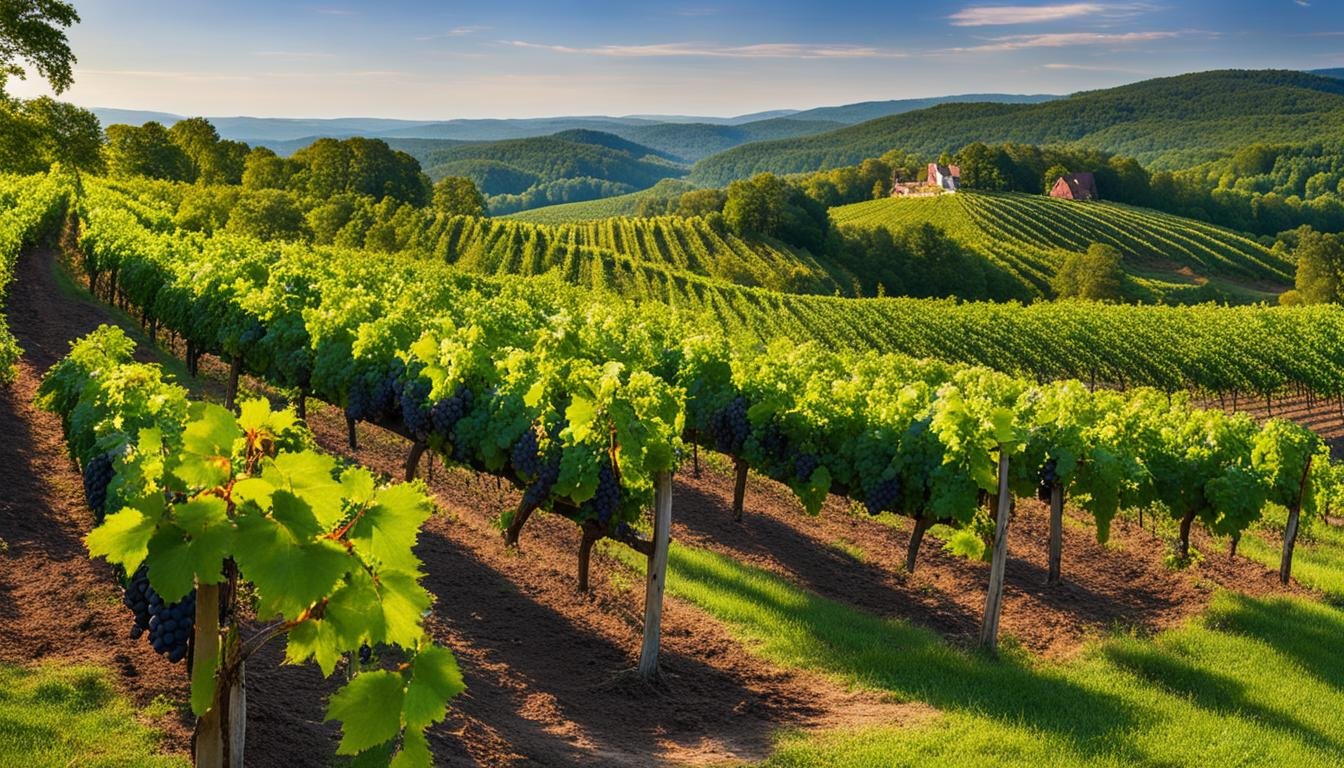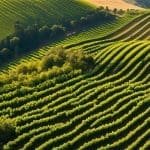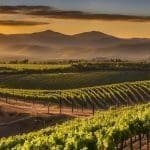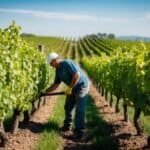Welcome to the world of Virginia wines, where history and flavours blend to create a truly unforgettable experience. As an Aussie wine lover, I couldn’t help but immerse myself in the wonders of Virginia’s wine culture, and let me tell you, it’s a journey you won’t want to miss!
Virginia wine production dates all the way back to the 17th century, making it one of America’s most historic wine regions. With over 250 wineries spread across the picturesque landscape, Virginia boasts a diverse selection of grape varieties, including the ever-popular Chardonnay, Cabernet Franc, Merlot, Vidal Blanc, and Viognier.
The unique geography and climate of Virginia contribute to the distinct character of its wines. From the humid subtropical regions to the highland continental areas, each sip offers a taste of the state’s rich terroir and the winemakers’ dedication to their craft.
If you’re eager to explore this historic wine region, there are plenty of wine tours and vineyard visits waiting for you. Take a leisurely stroll through the vineyards, indulge in wine tastings, and bask in the charm of Virginia’s wine country. Whether you’re an American wine enthusiast or a curious Aussie looking to expand your palate, Virginia has something for everyone.
Key Takeaways:
- Virginia is one of America’s most historic wine regions, with a winemaking history that dates back to the 17th century.
- The state is home to over 250 wineries, offering a wide variety of grape varieties, including Chardonnay, Cabernet Franc, Merlot, Vidal Blanc, and Viognier.
- Virginia’s diverse geography and climate contribute to the unique character of its wines.
- Visitors can explore Virginia’s wine region through wine tours and vineyard visits, enjoying the charm of the countryside and experiencing the flavours of local wines.
- Whether you’re an American wine lover or an adventurous Aussie seeking new experiences, Virginia’s historic wine region is a must-visit destination for wine tours, vineyard visits, and wine tasting.
The History of Virginia Wine
Virginia has a fascinating history when it comes to wine production, dating back to the colonial era. In fact, as early as 1619, the colonists in Virginia were required by law to plant vineyards, recognizing the potential of the region for viticulture.
One of the most notable advocates for Virginia wine was Thomas Jefferson, one of the greatest patrons of wine in the United States. In the 1800s, Jefferson attempted to grow grapes at his Monticello estate, but unfortunately, he faced significant challenges with disease. Despite his setbacks, Jefferson’s passion for wine and belief in the potential of Virginia as a wine region planted a seed that would eventually lead to its flourishing industry.
During the early 1900s, Charlottesville’s Monticello Wine Company gained recognition as a leading producer, particularly with its Virginia Claret Wine. It proudly declared itself as the “Capital of the Wine Belt in Virginia,” setting the stage for the region’s future success.
However, the modern Virginia wine industry experienced a true revival in the 1970s. Wineries like Barboursville Vineyards and Oakencroft Vineyards emerged, paving the way for the growth and development of the industry we see today. Today, Virginia boasts over 230 wineries, each contributing to the thriving wine culture and creating exceptional wines.
“Virginia’s rich wine history, dating back to the colonial era, has shaped the industry we know today. From the early struggles faced by Thomas Jefferson to the resurgence of winemaking in the 1970s, Virginia’s wine history adds depth and character to every bottle produced.”
To gain a deeper understanding of Virginia’s winemaking journey, it is essential to explore the Monticello Wine Company’s legacy and the contributions of pioneering wineries like Barboursville Vineyards and Oakencroft Vineyards.
| Key Historical Milestones | Significance |
|---|---|
| 1619 | The Virginia colonists are required by law to plant vineyards, foreshadowing the region’s wine-producing potential. |
| 1800s | Thomas Jefferson attempts to grow grapes at his Monticello estate, but faces challenges with disease. |
| Early 1900s | Charlottesville’s Monticello Wine Company gains recognition for its Virginia Claret Wine, positioning itself as a leading producer in the region. |
| 1970s | Barboursville Vineyards and Oakencroft Vineyards establish themselves as influential wineries, sparking the revival of the Virginia wine industry. |
The Virginia Wine Industry
The Virginia wine industry is vibrant and diverse, with a rich tapestry of wine regions and American Viticultural Areas (AVAs). These regions contribute to the state’s reputation as a premier wine destination, attracting both local enthusiasts and international connoisseurs. Let’s explore the key aspects of the Virginia wine industry, including the AVAs, wine production, and vineyard area.
Virginia Wine Regions and AVAs
Virginia is home to ten distinct wine regions, each with its own unique characteristics and microclimates. These regions include Middleburg, Monticello, and Shenandoah Valley, among others. The American Viticultural Areas (AVAs) within Virginia provide official recognition to specific wine-growing regions that have demonstrated unique qualities. These AVAs further deepen the understanding and appreciation of Virginia wines, showcasing the diverse terroir that influences wine production.
Wine Production and Vineyard Area
In terms of wine production, Virginia ranks fifth in the nation for both bearing acreage and grape production. The state’s vineyard area covers approximately 2,600 acres, with the majority of production concentrated in central and northern Virginia. The climate and geology of each region play a significant role in shaping the character of the wines produced in Virginia. From the rolling hills of the Piedmont region to the breezes of the Chesapeake Bay, the diverse landscapes contribute to the flavourful and distinctive wines that the state is known for.
With over 250 wineries, the Virginia wine industry encompasses a range of operations, from small family-owned vineyards to larger wineries with extensive distribution networks. This diversity allows for a wide range of wine styles and varietals, ensuring that every wine enthusiast can find something to delight their palate. Additionally, wine tourism and direct sales are integral to the industry’s success, with wineries hosting special events and offering wine tastings to attract visitors from near and far.
| Vineyard Region | Vineyard Area (acres) | Wineries |
|---|---|---|
| Middleburg AVA | 400 | 15 |
| Monticello AVA | 550 | 30 |
| Shenandoah Valley AVA | 700 | 35 |
| Other Regions | 950 | 170 |
Conclusion
Virginia’s historic wine region is a must-visit destination for wine lovers and tourists alike. With its rich history of wine production dating back to the colonial era and the vibrant revival of the industry in the 1970s, Virginia has become a hub for exceptional wines in the United States.
Featuring over 250 wineries, Virginia offers a wide variety of grape varieties, ensuring that there is something to satisfy every palate. Whether you prefer the crispness of a Chardonnay, the elegance of a Cabernet Franc, or the aromatic notes of a Viognier, Virginia’s wine industry delivers exquisite options.
Exploring the charm of Virginia’s vineyards is an experience not to be missed. From engaging wine tours to delightful vineyard visits, visitors can immerse themselves in the beauty of the region while indulging in tastings that showcase the unique terroir of the area.
So, whether you are a wine enthusiast seeking to expand your knowledge or a tourist looking for a memorable experience, consider Virginia as your next wine-tasting destination. Discover the allure of Virginia wines, delve into its thriving wine industry, and embark on an unforgettable wine tourism journey that includes vineyard visits and tastings.
FAQ
What is Virginia wine?
Virginia wine refers to wine made primarily from grapes grown in the commonwealth of Virginia.
How long has wine production been happening in Virginia?
Wine production in Virginia dates back to the 17th century, making it one of America’s historic wine regions.
What types of grapes are grown in Virginia?
Virginia has a wide variety of grape varieties, including Chardonnay, Cabernet Franc, Merlot, Vidal Blanc, and Viognier.
What contributes to the unique character of Virginia wines?
The state’s diverse geography and climate, ranging from humid subtropical to highland continental, contribute to the unique character of Virginia wines.
How can visitors explore the Virginia wine region?
Visitors can explore the region through wine tours and vineyard visits, enjoying the charm of this historic wine region and experiencing its modern tastings.
What is the history of wine production in Virginia?
Virginia has a rich history of wine production that dates back to the colonial era. Thomas Jefferson and the Monticello Wine Company played significant roles in its early years.
How many wineries are there in Virginia?
Virginia is home to over 250 wineries, ranging from small family-owned operations to larger wineries with distribution networks.
Where are the main wine regions in Virginia?
Virginia is divided into ten regions and eight American Viticultural Areas (AVAs), including Middleburg AVA, Monticello AVA, and Shenandoah Valley AVA.
How much vineyard area does Virginia have?
Virginia’s vineyard area covers approximately 2,600 acres, with the majority of production concentrated in central and northern Virginia.
What is the role of wine tourism in Virginia’s wine industry?
Wine tourism and direct sales play a significant role in supporting the industry, with wineries hosting special events and offering wine tastings to attract visitors.
Why should I visit Virginia’s vineyards?
Virginia’s historic wine region offers a unique and diverse wine experience for both wine enthusiasts and tourists, making it a must-visit destination for wine lovers.
Source Links
User Review
( votes)Sip smarter, subscribe now!
Subscribe for gourmet tips, event updates, travel ideas, and a free e-book on Food Pairings. Start your journey to culinary and travel excellence!













